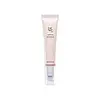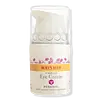What's inside
What's inside
 Key Ingredients
Key Ingredients

 Benefits
Benefits

 Concerns
Concerns

 Ingredients Side-by-side
Ingredients Side-by-side

Water
Skin ConditioningPanax Ginseng Root Extract
EmollientGlycerin
HumectantDipropylene Glycol
HumectantCaprylic/Capric Triglyceride
Masking1,2-Hexanediol
Skin ConditioningPentaerythrityl Tetraethylhexanoate
EmollientNiacinamide
SmoothingButylene Glycol Dicaprylate/Dicaprate
EmollientCetearyl Alcohol
EmollientSorbitan Olivate
EmulsifyingCetearyl Olivate
Butylene Glycol
HumectantHydrogenated Lecithin
EmulsifyingTromethamine
BufferingCarbomer
Emulsion StabilisingGlyceryl Stearate
EmollientMacadamia Ternifolia Seed Oil
EmollientAdenosine
Skin ConditioningTheobroma Cacao Extract
Skin ConditioningDextrin
AbsorbentCholesterol
EmollientPolyglyceryl-10 Oleate
Skin ConditioningRetinal
Skin ConditioningBrassica Campestris Sterols
EmollientPhytosteryl/Behenyl/Octyldodecyl Lauroyl Glutamate
Skin ConditioningSilica
AbrasiveSodium Hyaluronate
HumectantTocopherol
AntioxidantAluminum/Magnesium Hydroxide Stearate
Emulsion StabilisingPotassium Cetyl Phosphate
EmulsifyingPentaerythrityl Tetra-Di-T-Butyl Hydroxyhydrocinnamate
AntioxidantCeramide NP
Skin ConditioningPalmitoyl Tripeptide-5
Skin ConditioningDisodium EDTA
Ethylhexylglycerin
Skin ConditioningWater, Panax Ginseng Root Extract, Glycerin, Dipropylene Glycol, Caprylic/Capric Triglyceride, 1,2-Hexanediol, Pentaerythrityl Tetraethylhexanoate, Niacinamide, Butylene Glycol Dicaprylate/Dicaprate, Cetearyl Alcohol, Sorbitan Olivate, Cetearyl Olivate, Butylene Glycol, Hydrogenated Lecithin, Tromethamine, Carbomer, Glyceryl Stearate, Macadamia Ternifolia Seed Oil, Adenosine, Theobroma Cacao Extract, Dextrin, Cholesterol, Polyglyceryl-10 Oleate, Retinal, Brassica Campestris Sterols, Phytosteryl/Behenyl/Octyldodecyl Lauroyl Glutamate, Silica, Sodium Hyaluronate, Tocopherol, Aluminum/Magnesium Hydroxide Stearate, Potassium Cetyl Phosphate, Pentaerythrityl Tetra-Di-T-Butyl Hydroxyhydrocinnamate, Ceramide NP, Palmitoyl Tripeptide-5, Disodium EDTA, Ethylhexylglycerin
Water
Skin ConditioningCaprylic/Capric Triglyceride
MaskingGlycerin
HumectantStearyl Alcohol
EmollientCetyl Alcohol
EmollientGlyceryl Stearate
EmollientBeeswax
Emulsion StabilisingBakuchiol
AntimicrobialTocopherol
AntioxidantBeta Vulgaris Root Extract
Skin ConditioningCitrullus Lanatus Fruit Extract
Skin ConditioningLens Esculenta Fruit Extract
Skin ConditioningPyrus Malus Fruit Extract
Skin ConditioningGlycine Soja Oil
EmollientScutellaria Alpina Flower/Leaf/Stem Extract
Skin ConditioningTrifolium Pratense Leaf Extract
AntioxidantAdansonia Digitata Fruit Extract
EmollientHibiscus Sabdariffa Flower Extract
Skin ConditioningChlorella Vulgaris Extract
Skin ConditioningPlankton Extract
Skin ConditioningPhragmites Communis Extract
Skin ConditioningPoria Cocos Extract
Skin ConditioningStearic Acid
CleansingRibose
HumectantXanthan Gum
EmulsifyingLecithin
EmollientHydrolyzed Corn Starch
HumectantCitric Acid
BufferingDipotassium Glycyrrhizate
HumectantP-Anisic Acid
MaskingPotassium Stearate
CleansingLinoleic Acid
CleansingLinolenic Acid
CleansingLactic Acid
BufferingMagnesium Aluminum Silicate
AbsorbentSodium Lactate
BufferingSodium PCA
HumectantSodium Citrate
BufferingSodium Benzoate
MaskingPotassium Sorbate
PreservativePhenoxyethanol
PreservativeWater, Caprylic/Capric Triglyceride, Glycerin, Stearyl Alcohol, Cetyl Alcohol, Glyceryl Stearate, Beeswax, Bakuchiol, Tocopherol, Beta Vulgaris Root Extract, Citrullus Lanatus Fruit Extract, Lens Esculenta Fruit Extract, Pyrus Malus Fruit Extract, Glycine Soja Oil, Scutellaria Alpina Flower/Leaf/Stem Extract, Trifolium Pratense Leaf Extract, Adansonia Digitata Fruit Extract, Hibiscus Sabdariffa Flower Extract, Chlorella Vulgaris Extract, Plankton Extract, Phragmites Communis Extract, Poria Cocos Extract, Stearic Acid, Ribose, Xanthan Gum, Lecithin, Hydrolyzed Corn Starch, Citric Acid, Dipotassium Glycyrrhizate, P-Anisic Acid, Potassium Stearate, Linoleic Acid, Linolenic Acid, Lactic Acid, Magnesium Aluminum Silicate, Sodium Lactate, Sodium PCA, Sodium Citrate, Sodium Benzoate, Potassium Sorbate, Phenoxyethanol
 Reviews
Reviews

Ingredients Explained
These ingredients are found in both products.
Ingredients higher up in an ingredient list are typically present in a larger amount.
This ingredient is an emollient, solvent, and texture enhancer. It is considered a skin-softener by helping the skin prevent moisture loss.
It helps thicken a product's formula and makes it easier to spread by dissolving clumping compounds.
Caprylic Triglyceride is made by combining glycerin with coconut oil, forming a clear liquid.
While there is an assumption Caprylic Triglyceride can clog pores due to it being derived from coconut oil, there is no research supporting this.
Learn more about Caprylic/Capric TriglycerideGlycerin is already naturally found in your skin. It helps moisturize and protect your skin.
A study from 2016 found glycerin to be more effective as a humectant than AHAs and hyaluronic acid.
As a humectant, it helps the skin stay hydrated by pulling moisture to your skin. The low molecular weight of glycerin allows it to pull moisture into the deeper layers of your skin.
Hydrated skin improves your skin barrier; Your skin barrier helps protect against irritants and bacteria.
Glycerin has also been found to have antimicrobial and antiviral properties. Due to these properties, glycerin is often used in wound and burn treatments.
In cosmetics, glycerin is usually derived from plants such as soybean or palm. However, it can also be sourced from animals, such as tallow or animal fat.
This ingredient is organic, colorless, odorless, and non-toxic.
Glycerin is the name for this ingredient in American English. British English uses Glycerol/Glycerine.
Learn more about GlycerinGlyceryl Stearate is a mix of glycerin and stearic acid.
It is used to stabilize the mixing of water and oil ingredients. By preventing these ingredients from separating, it can help elongate shelf life. It can also help thicken the product's texture.
As an emollient, it helps soften skin and supports barrier-replenishing ingredients.
In cosmetics, Glyceryl Stearate is often made from vegetable oils or synthetically produced.
This ingredient may not be fungal-acne safe
Fun fact: The human body also creates Glyceryl Stearate naturally.
Learn more about Glyceryl StearateTocopherol (also known as Vitamin E) is a common antioxidant used to help protect the skin from free-radicals and strengthen the skin barrier. It's also fat soluble - this means our skin is great at absorbing it.
Vitamin E also helps keep your natural skin lipids healthy. Your lipid skin barrier naturally consists of lipids, ceramides, and fatty acids. Vitamin E offers extra protection for your skin’s lipid barrier, keeping your skin healthy and nourished.
Another benefit is a bit of UV protection. Vitamin E helps reduce the damage caused by UVB rays. (It should not replace your sunscreen). Combining it with Vitamin C can decrease sunburned cells and hyperpigmentation after UV exposure.
You might have noticed Vitamin E + C often paired together. This is because it is great at stabilizing Vitamin C. Using the two together helps increase the effectiveness of both ingredients.
There are often claims that Vitamin E can reduce/prevent scarring, but these claims haven't been confirmed by scientific research.
Learn more about TocopherolWater. It's the most common cosmetic ingredient of all. You'll usually see it at the top of ingredient lists, meaning that it makes up the largest part of the product.
So why is it so popular? Water most often acts as a solvent - this means that it helps dissolve other ingredients into the formulation.
You'll also recognize water as that liquid we all need to stay alive. If you see this, drink a glass of water. Stay hydrated!
Learn more about Water